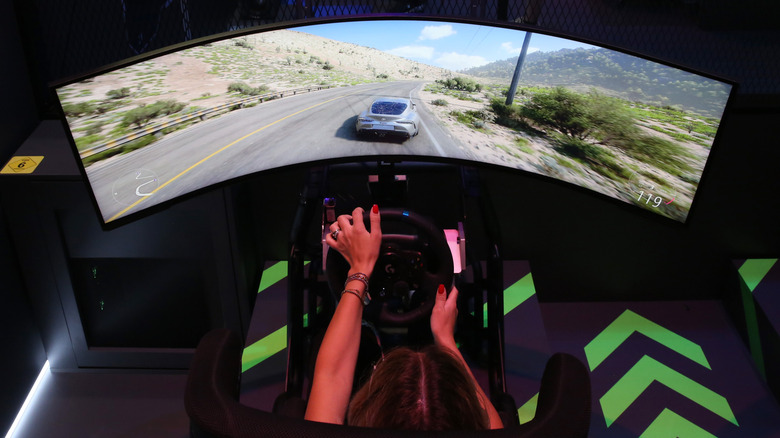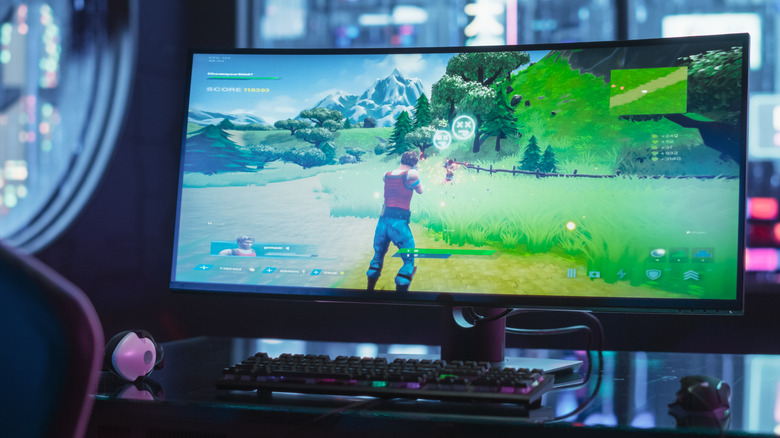Are Curved Monitors Really Better For Gaming? The Benefits & Drawbacks Explored
Back in the 2010s, gamers were all over the debate between CRT boxes and LCD screens, with the latter being more of a game-changer at the time. Today, it's a whole new story with gaming monitors: Now, it's more about shape, and less about the type of display. Some gamers still swear by their flat monitors, and others can't get enough of their curved screens, which raises the question: Are curved monitors really better for gaming, or is it just a gimmick?
Compared to flat screens, curved monitors just have a lot to offer in terms of user experience. And that's most likely the reason why gamers are increasingly shifting from flat screens. Curved monitors make the action in a game seem more realistic by creating the illusion of peripheral vision. But immersion isn't all, though. They also offer a far wider field of view, reduce distortion, and strain on your eyes.
Even so, the viewing experience itself is the only real difference between curved and flat monitors. Otherwise, they are quite similar in tech terms. There are even instances in gaming where flat monitors may outshine curved rivals, particularly in competitive gaming. Are curved monitors better for gaming? Well, that comes down to personal preference, depending on the type of gaming setup you want — single ultrawide screen, or dual monitors — and the games you play.
Where curved monitors shine in gaming
The real charm of curved monitors has mostly to do with immersion and comfort. The curve allows them to offer larger ultra-wide displays, which gently wrap the screen around your natural field of vision, allowing you to see more of the game without having to turn your head at all. That's a huge deal if you're into aviation-sims, open-world, and racing games, and often have long gaming sessions. In fact, a study by Harvard for Samsung in 2016 showed that curved monitors significantly reduce eye strain and improve focus.
Curved monitors also often come with anti-glare coatings, which are complemented by the curved screen design to help minimize glare and reflections from any light sources. Also, there's no denying the style and sophistication that curved monitors add to any setting, all thanks to their seamless design. If futuristic is more of your thing, you sure can't go wrong with a curved monitor in your gaming setup.
Most models also boast adaptive sync tech, such as G-Sync, VSync and FreeSync, so performance is not sacrificed for design. All these offerings are great, to say the least. But you can only best enjoy them on bigger displays — a cheaper 24-inch curved monitor is only going to look cool, no bells and whistles.
The drawbacks of curved monitors you shouldn't ignore
Curved monitors have proven popular, with Samsung as the pioneer with the 27-inch SE790C curved monitor released in 2014. However, just like other devices and gear, they have their share of downsides. For starters, curved monitors cost more than their flat counterparts, as they require more complex manufacturing. However, the enhanced viewing experience they offer makes them worth it, and they might even save you the need to invest in a multi-monitor setup, which can prove costlier overall.
The new viewing experience may also feel quite strange on your eyes at first, and it might take you a while to get used to it. Curved monitors are also limited in their viewing angles, with the optimal experience only happening when seated directly in front of the screen. So, during couch co-op games with your friends and instances where several people need to view the screen at the same time, the image may appear distorted or washed out from the sides.
You also need a little bit more of space than you would for a flat screen with the same size, especially if you opt for a bigger curved monitor or a sharp curve — don't forget to assess your available desk space before going shopping.


